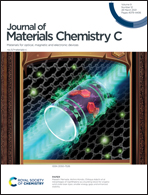Highly air-stable, n-doped conjugated polymers achieved by dimeric organometallic dopants†
Abstract
Chemical doping is a key process for controlling the electronic properties of molecular semiconductors, including their conductivity and work function. A common limitation of n-doped polymers is their instability under ambient conditions, which has imposed restrictions on the characterisation and device application of n-doped polymers. In this study, sequential n-doping with organometallic dopants was performed on thin films of polymeric semiconductors with naphthalene diimide and perylene diimide-based backbones. Moderate ambient stability was achieved with (RuCp*Mes)2, {Cp* = pentamethylcyclopentadienyl; Mes = 1,3,5-trimethylbenzene}, which is in striking contrast to the unstable, n-doped state obtained with cobaltocene, a simple one-electron reductant. The highly cathodic, effective redox potential of (RuCp*Mes)2, ca. −2.0 V vs. ferrocene, suppresses the back electron transfer reaction and the subsequent dopant loss in air, which gives rise to the observed air stability. It also allows a perylene diimide-based polymer to be reduced to a state in which the repeat units are largely dianionic. Photoelectron measurements show that the ionization potential of the heavily doped polymer is ca. 3.9 eV. Our findings show that chemical doping with (RuCp*Mes)2 is an effective method to produce highly stable, n-doped conjugated polymers.



 Please wait while we load your content...
Please wait while we load your content...